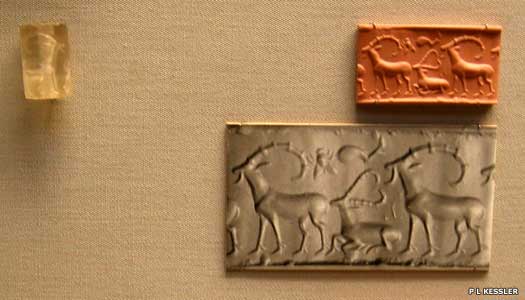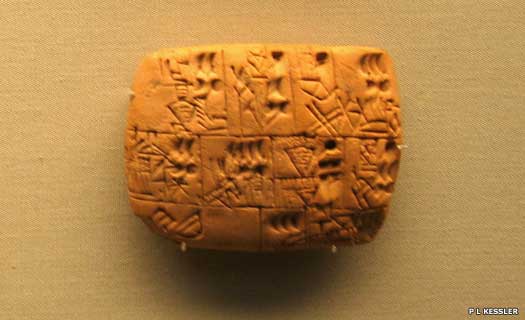
| HARRAN (CARRHAE) Situated on the border between modern Syria, Turkey, and Iraq (and now part of south-eastern Turkey), far up the Euphrates, Harran was an early Mesopotamian city state founded in the mid-third millennium BC. It served as a religious centre, but the main reason for its early existence was its location on the trade route across northern Mesopotamia and down to Ur in the south. Details of its early rule are very sketchy, but it seems to have begun its life as a part of the kingdom of Ebla. Carrhae itself is a now-unused portion of the site which is famous for being the site of Rome's disastrous battle against Parthia in 53 BC, while Harran is better known for its relatively modern beehive houses.
fl c.2400 BC :
Zugalum : Eblaite princess who married the king of Harran.
c.2334 - 1900 BC :
Harran's
fortunes follow those of its parent city of Ebla.

A rock crystal cylinder seal of the Early Dynastic I period in Mesopotamia (around 2800 BC) showing two ibex, a gazelle, an animal's leg and a fly c.1800 - 1761 BC :
The powerful city state of Mari conquers Harran. Early Assyrian influences make Harran a centre for the moon god Sin, which retains its hold well into the Christian era.
fl c.1775 - 1750 BC :
Itur Asdu : Vassal of Mari.
c.1750 BC :
The Semitic Israelite tribes following Terah from Ur temporarily settle in Harran before moving southwards into Canaan.
c.1750s - 1600 BC :
The city is controlled by various Akkadian groups.
c.1600 BC :
Aramaean groups secure the city of Harran and create an Aramaean state.
Aram-Nahara'im (Padan-Aram / Bit Nahreen) :
Aramaeans began infiltrating into the northern edges of Syria, although at first they were held back by the power of Mitanni. However, they did secure a foothold in Harran, creating their own minor kingdom there. The new form of the city's name meant 'Aram of the rivers'. Records for the city are extremely poor, although the city is known to have traded with its regional neighbours, including Tyre. The near-legendary Aram ben Nahor is the Israelite leader Abraham's brother in the Bible, and it is he, or alternatively his grandson, Aram-Naharaim who is considered to be ancestral to all Aramaeans.
c.1700 BC :
Aram ben Nahor : Israelite ancestor king of all Aramaeans.
c.1630 BC :
Aram-Naharaim : Grandson.
fl c.1600s? BC :
Bethuel ben Nahor
fl c.1600s? BC :
Lavan bar Bethuel
c.1320s BC :
Harran is reduced by Piyashshili, son of Hittite king, Suppiluliuma I, as part of the conquest of Mitanni.
fl c.1290s BC :
Be'or
c.1270 - 1260 BC :
Balaam
fl c.1140 BC :
Cushan-Rishataim?
c.1140 BC :
Israel is apparently under Aramaean rule for eight years, until Cushan-Rishataim is defeated by Othniel.
Sumerian script remained the Latin of ancient Mesopotamia long after the fall of Sumerian civilisation itself. This tablet contains a record of beer c.900 BC :
The city is conquered by Assyria as part of a general campaign to halt Aramaean raids. It serves as a regional capital.
763 BC :
Harran is sacked by Assyria and subsequently restored under Sargon II.
fl c.730 BC :
Bel-Pihati : Assyrian vassal.
612 - 609 BC :
The Assyrian empire is destroyed, but the commander of the Assyrian western army, based in Harran, claims the crown. In 610 BC Harran is conquered, but not completely destroyed, and by 609 BC the remaining Assyrians surrender and the city is firmly in the hands of Babylonia (or the Median empire, the existence of which is questionable).
550s BC :
Nabo-Balatu-Ikbi : Father of Nabonidus of Babylonia.
556 BC :
The son of Nabo-Balatu-Ikbi, Nabonidus, becomes king of Babylonia. His son, Nabo-Naid (which itself seems to be an alternate version of the name Nabonidus), gains the throne in Harran in his stead. Nabonidus' mother is high priestess at Harran while his daughter fills the same role at Ur.
540s BC :
Nabo-Naid : Son of Nabonidus, last king of Babylonia.
539 - 332 BC :
The region passes to the Persian empire when the Achaemenid king enters Babylon.
333 - 332 BC :
In 334 BC Alexander of Macedon launches his campaign into the Persian empire by crossing the Dardanelles. Much of Anatolia falls by 333 BC and Alexander proceeds into Syria during 333-332 BC to receive the submission of Ebir-nāri, which also gains him Harran, Judah, and Phoenicia (principally Byblos and Sidon, with Tyre holding out until it can be taken by force). Athura, Gaza, and Egypt also capitulate (not without a struggle in Gaza's case).
323 - 301 BC :
Upon the death of Alexander, Harran becomes part of the Antigonid empire.
301 - c.80 BC :
The Seleucid empire controls the region, and the city becomes the capital of the province of Osrhoene.
c.80 - 66 BC :
Armenia takes Harran.
66 BC - AD 116 :
The Parthians take control of the region, but Harran, now part of Osrhoene, gains independence and acts as a buffer zone between Parthians and Seleucids.
53 BC :
A Roman army under Triumvir Crassus is destroyed by a Parthian army in what Rome terms the Battle of Carrhae (in other words, Harran). Subsequent legend says that a small band of Roman prisoners wander through the desert and are eventually rounded up by the Han military seventeen years later (36 BC).
AD 116 - 232 :
The Romans conquer the region from the Parthians.
232 - 242 :
The Sassanids briefly conquer the region.
242 - 296 :
Rome re-takes the region.
296 - 651 :
The Sassanids defeat Emperor Galerius, and this time they hold onto the region until it is conquered by the Islamic empire.
Source :
https://www.historyfiles.co.uk/ |
